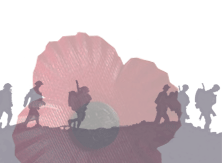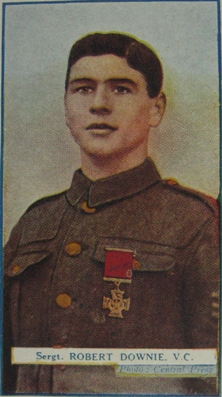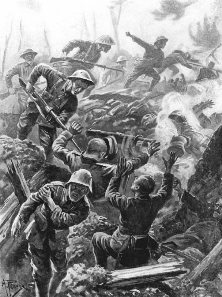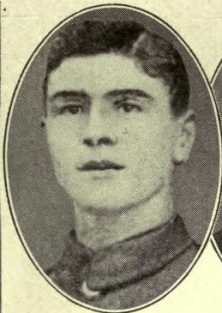Robert Downie VC
Their names will be remembered for evermoreIt had been a desperate day. Gun Pits, a well-fortified German machine gun post east of Les Boeufs, had hammered at soldiers of the 4th division including the Royal Dublin Fusiliers. With his officers and comrades cut down around him, Glasgow-born Sergeant Robert Downie issued a battle cry "Come on, the Dubs" and charged against the murderous guns. Downie, one of 13 children of an Irish father and Dundee-born mother, had worked alongside his father and two brothers in the Hydepark Locomotive Works in Springburn until his 18th birthday, when he joined the Irish regiment of the British army in 1912. When war broke out Downie, already married, was sent to France with his regiment and saw heavy fighting from the start of the campaign on the Western Front. He had already suffered in a gas attack and had been awarded the Military Medal when he showed the outstanding courage that earned him the VC on 23 October, 1916, the 115th day of the First Battle of the Somme. Hundreds Cut Down Hours of bloody hand-to-hand fighting for the strategically important position had left the Irish troops exhausted and severely depleted: five officers and 124 men were wounded and 36 were missing. The fusiliers went over the top at 2.30pm, but hundreds were cut down at close range. Survivors crawled back through the mud to their dug-outs. Orders were given to take no German prisoners and bayonets were fixed. Again and again, the Germans defended their line. One officer described them as "beasts at bay" counter-attacking and pinning the Dublin Fusiliers into hastily dug mud-filled trenches. Battle Cry Rallies Men With the last officer dead, Downie took command. He rallied the troops under heavy fire and rushed forward alone, issuing his battle cry. Inspired, the exhausted men joined the charge. Downie killed several Germans and took the machine gun, killing the team which had inflicted so much suffering on his comrades. Alongside the wounded and missing, the Gun Pits crew had claimed the lives of three officers and 14 men. Downie was wounded, but the gun position was finally taken. It was a day so bloody that Downie never spoke of it to anyone again, not even in his own family. A professional soldier, Downie had once joked with friends about bringing home the VC. After he was awarded the honour, he told the press: "Every man in the regiment won the VC that day". Downie arrived home to Carleston Street, Springburn on Hogmanay 1916. From that one street, over 200 had joined the army. Sixteen had been killed and five had lost limbs. He was presented to the City Council and attended a public reception at Springburn Public Halls. He was feted by St Aloysius Church and School, and local dignitaries. Two of Downie's brothers, David and Richard, who had welcomed him home, died in France in 1917. After the war Robert Downie VC became a groundsman and turnstile cashier at Celtic Football Club. He died in 1968 and is buried in St Kentigern's Cemetery, Glasgow. Robert Downie's citation in The London Gazette View original referenced text here: |
Images:
|















